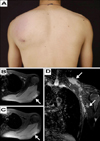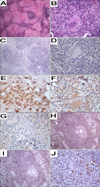Abstract
Rosai-Dorfman disease is a rare, idiopathic, benign, and self-limiting histiocytic proliferative disorder. A 26-year-old man presented with a single massive cutaneous nodule (reaching 30 cm in diameter) on the left shoulder and back for 15 months. The routine hematological and biochemical tests were normal. Magnetic resonance scanning showed the lesion involved the skin, subcutaneous tissue, and subjacent muscle group, accompanied by obvious lymph node enlargement in the left part of the neck, supraclavicular fossa, and axillary fossa. The histopathology of the left cervical lymph node revealed diffuse effacement of the normal nodal architecture, with patchy chronic inflammatory cell infiltrates comprising lymphocytes and sheets of histiocytes. Some histiocytes contained lymphocytes within their pale cytoplasm. Many multinucleated giant cells were found; however, caseating granulomas were not seen. The skin and muscle biopsy specimen obtained from the back revealed infiltrating lymphocytes and histiocytes diffusely distributed in the dermis, subcutaneous tissue, and crevices of the muscle fibers. The phenomenon of emperipolesis and the presence of multinucleated giant cells were also seen. Immunohistochemical staining revealed that the histiocytes were positive for S-100 protein and CD68 but negative for CD1a. Immunophenotyping of the infiltrating lymphocytes indicated positive reactions to CD3, CD45RO, CD5, CD7, CD4, CD8 (partly), CD79a, CD20 (partly), and Ki-67 (<1%). The final diagnosis was Rosai-Dorfman disease. Owing to the extensive and deep involvement of the subcutaneous tissue and muscles, the patient did not undergo surgery to excise the massive skin nodule. The lesion showed no obvious change at the 12-month follow-up.
Rosai-Dorfman disease (RDD) is a rare benign disorder of histiocytic proliferation. The etiology is still unknown; however, genetic, infectious, and inflammatory mechanisms have been postulated. In most cases, the clinical course is benign and self-limiting, and no treatment is necessary. However, in patients with massive nodal or extranodal involvement with life-threatening organ dysfunction, therapy is indicated1. Surgical resection has been found to be most effective, and often results in long-term remission of the disease. We report a case of a young male RDD patient with a massive cutaneous nodule on the shoulder and back, including a review of the literature to help dermatologists be familiar with the primary clinical presentation and pathologic features, and diagnose the disease early and correctly.
A 26-year-old man presented with a single massive cutaneous nodule (reaching 30 cm in diameter) on the left shoulder and back that had been present for 15 months (Fig. 1A). The lesion grew in size progressively, with no pain and pruritus. An irregular, dark red patch was noted on the exterior skin. He had no symptom of fever or weight loss; however, there was little malaise when stretching the shoulder joint. There was no mucosal involvement. He was unresponsive to a 3-month course of itraconazole (0.4 g/day), administered before his initial visit to our hospital's department of dermatology. Physical examination revealed many enlarged superficial lymph nodes in both sides of the neck, axillary fossa, and groin, especially the left part. The routine hematological and biochemical tests were normal. Magnetic resonance scanning showed that the lesion was predominantly located on the shoulder and back, involving the skin, subcutaneous tissue, and subjacent muscle group (Fig. 1B, C), and was accompanied by obvious lymph node enlargement in the left part of the neck, supraclavicular fossa, and axillary fossa (Fig. 1D). Left cervical lymph node biopsy was performed, and microscopic examination revealed diffuse effacement of the normal nodal architecture with patchy chronic inflammatory cell infiltrates comprising lymphocytes and sheets of histiocytes (Fig. 2A). Some histiocytes contained lymphocytes within their pale cytoplasm, suggesting emperipolesis (Fig. 2B). Many multinucleated giant cells were found; however, caseating granulomas were not seen. The skin and muscle biopsy specimen obtained from the back revealed infiltrating lymphocytes and histiocytes diffusely distributed in the dermis (Fig. 2C), subcutaneous tissue, and crevices of the muscle fibers. The phenomenon of emperipolesis and the presence of multinucleated giant cells were also seen (Fig. 2D). Immunohistochemical staining revealed that the histiocytes were positive for S-100 protein (Fig. 2E) and CD68 (Fig. 2F) but negative for CD1a (Fig. 2G). Immunophenotyping of the infiltrating lymphocytes indicated positive reactions to CD3 (Fig. 2H), CD45RO, CD5, CD7, CD4, CD8 (partly), CD79a (Fig. 2I), CD20 (partly), and Ki-67 (<1%) (Fig. 2J). On the basis of clinical data and histopathologic findings, the diagnosis was concluded to be RDD with nodal and extranodal involvement. Owing to the extensive and deep involvement of the subcutaneous tissue and muscles, the patient did not undergo surgery to excise the massive skin nodule. Furthermore, he refused any topical and oral medicine. The massive lesion showed no obvious change at the 12-month follow-up.
RDD was first described by Rosai and Dorfman in 19692 as a sinus histiocytosis with massive lymphadenopathy. Classically, it presents as a bilateral painless cervical and paratracheal lymphadenopathy, which can be massive, in 90% of the cases3. Other less common sites, such as the axillary, inguinal, upper paraaortic, mediastinal, and subdiaphragmatic lymph nodes, have also been documented3,4. Extranodal involvement is most commonly reported in the eyes and ocular adnexa, head and neck region, upper respiratory tract, skin and subcutaneous tissue, and central nervous system. Other sites include the gastrointestinal tract, salivary glands, genitourinary tract, thyroid, breast, and testis5. Clinically, it can be classified into two forms: an indolent cutaneous form without systemic symptoms of fever, hypergammaglobulinemia, and leukocytosis, and a nodal form with or without systemic symptoms. The purely cutaneous form of the disease is very rare and usually presents as erythematous to brown papules, plaques, or nodules with no predilection for site6. Most cases occur during the first or second decades of life; however, any age group can be affected5. The clinical course in most cases is benign and self-limiting, and it can spontaneously regress without treatment and generally does not relapse. A few reported cases became progressive and required treatment secondary to life-threatening complications or organ dysfunction; prognosis is poor if there is involvement of the kidneys and lungs or widespread nodal dissemination4.
Histologically, nodal RDD is characterized by nodal sinus dilatation with nonneoplastic proliferation of histiocytes. This histiocytic proliferation may cause effacement of the normal nodal architecture, and nodal capsular fibrosis7. In particular, infiltrating histiocytes have one large nucleus, conspicuous central nucleolus, and an abundant clear and/or acidophilic cytoplasm. Emperiopolesis of lymphocytes, plasma cells, and red blood cells by large histiocytes is evident. Immunohistochemically, the histiocytes show reactivity to S-100 protein and CD68. Compared with nodal RDD, extranodal RDD shows more fibrosis, infrequent typical histiocytes, and a lesser degree of emperipolesis8.
The differential diagnosis includes lymphoma, malignant histiocytosis, disseminated tuberculosis, and Langerhans cell histiocytosis. The key finding in differentiating RDD from the rest of these diseases is the phenomenon of emperipolesis.
The etiology of RDD is still unknown. It has been noted to occur sporadically, with occasional clustering, which suggests a genetic or an infectious component. It has been suggested that RDD is linked to a reactive disorder since it arises from circulating mononuclear cells and there is an increase in autoimmune antibodies in some patients. Epstein-Bar virus and human herpes virus 6 have been proposed as the infectious agents. Furthermore, other disease-causing agents, including varicella zoster virus, cytomegalovirus, Brucella, and Klebsiella, have also been recently implicated. Meanwhile, it has been postulated that the development of RDD may be driven by irregular cytokine expression4.
Various kinds of treatment, such as steroids, chemotherapy, radiation therapy, acitretin, and surgery, have been applied for this disease; however, the outcomes differ. Surgery is considered the best choice for local disease, and often results in long-term remission of the disease9. However, in our case, the lesion could not be resected completely because of the extensive and deep involvement of the subcutaneous tissue and muscles-surgery in this case could result in damage to the motor function. A possibly suitable treatment for the patient is topical and systemic steroids or acitretin. When the massive skin nodule becomes smaller, surgical excision of the lesion may become feasible and effective.
Figures and Tables
Fig. 1
(A) Massive cutaneous nodule on the left shoulder and back. (B) Axial T2 weighted magnetic resonance image (MRI) shows a mass lesion (white arrow) with extension into muscle group of the left shoulder and back. (C) Gadolinium-enhanced axial T1 weighted MRI shows an enhancing mass lesion (white arrow). (D) Coronal T2 weighted MRI shows lymph nodes enlargement in the part of supraclavicular fossa and axillary fossa (white arrows).

Fig. 2
Histopathological features. Lymphocytes and histiocytes infiltrate in diffuse distribution in the lymph nodule (A) and dermis (C) (H&E, ×40). Histiocytes with emperipolesis in the lymph nodule (B) and dermis (D) (H&E, ×400). Immunopathological features. (E) S-100 stains (avidin-biotin-peroxidase complex [ABC] method, ×400). (F) CD68 stains (ABC method, ×400). (G) CD1a stains (ABC method, ×400). (H) CD3 stains (ABC method, ×100). (I) CD79a stains (ABC method, ×100). (J) Ki-67 stains (ABC method, ×400).

References
1. Pulsoni A, Anghel G, Falcucci P, Matera R, Pescarmona E, Ribersani M, et al. Treatment of sinus histiocytosis with massive lymphadenopathy (Rosai-Dorfman disease): report of a case and literature review. Am J Hematol. 2002; 69:67–71.

2. Rosai J, Dorfman RF. Sinus histiocytosis with massive lymphadenopathy. A newly recognized benign clinicopathological entity. Arch Pathol. 1969; 87:63–70.
3. Henter JI, Tondini C, Pritchard J. Histiocyte disorders. Crit Rev Oncol Hematol. 2004; 50:157–174.

4. Moore JC, Zhao X, Nelson EL. Concomitant sinus histiocytosis with massive lymphadenopathy (Rosai-Dorfman Disease) and diffuse large B-cell lymphoma: a case report. J Med Case Rep. 2008; 2:70.

5. Fernandopulle SM, Hwang JS, Kuick CH, Lui J, Tan PH, Siow WY, et al. Rosai-Dorfman disease of the testis: an unusual entity that mimics testicular malignancy. J Clin Pathol. 2006; 59:325–327.
6. Brenn T, Calonje E, Granter SR, Leonard N, Grayson W, Fletcher CD, et al. Cutaneous rosai-dorfman disease is a distinct clinical entity. Am J Dermatopathol. 2002; 24:385–391.

7. Andriko JA, Morrison A, Colegial CH, Davis BJ, Jones RV. Rosai-Dorfman disease isolated to the central nervous system: a report of 11 cases. Mod Pathol. 2001; 14:172–178.





 PDF
PDF ePub
ePub Citation
Citation Print
Print


 XML Download
XML Download